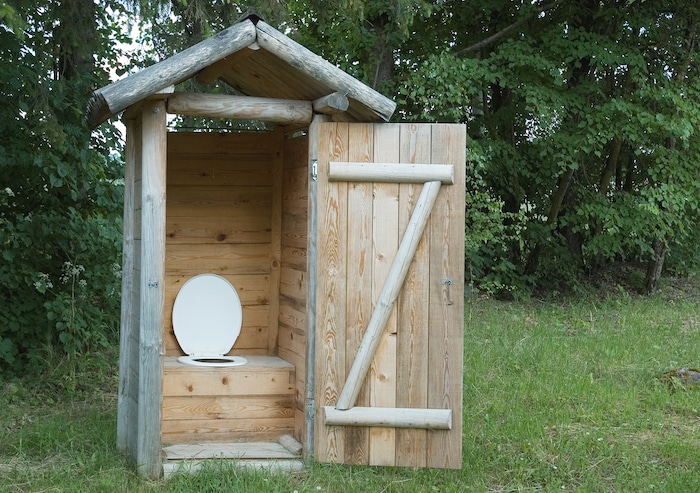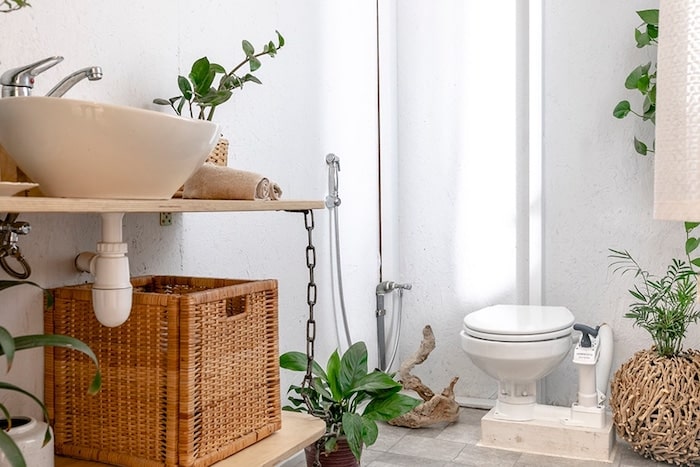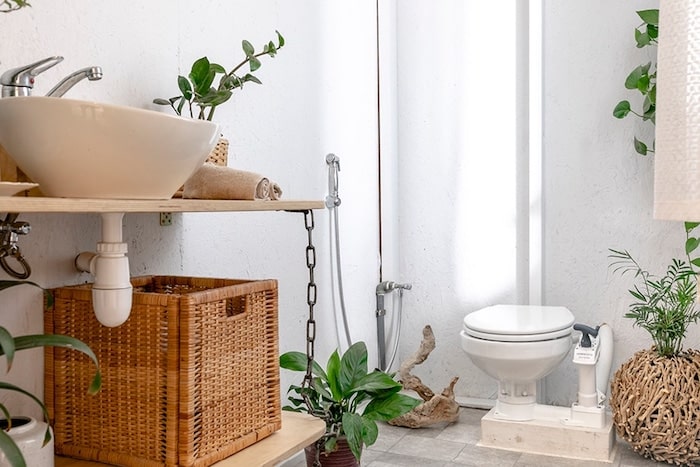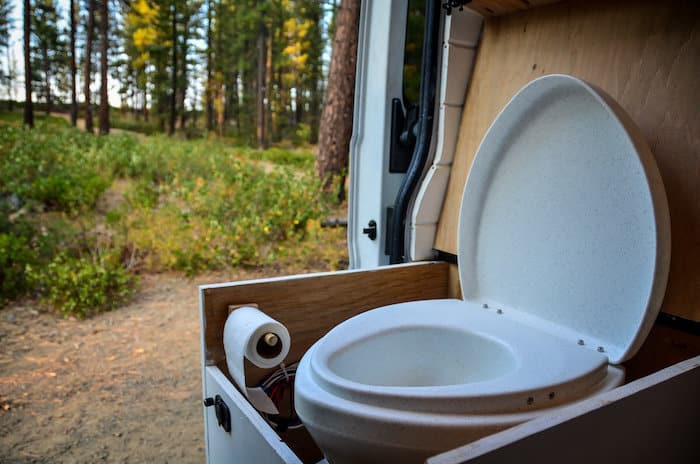
What is a self-contained toilet?
A self-contained toilet is a sanitation solution without plumbing or a central sewage system connection. Ideal for homes where conventional plumbing is impractical or undesirable, these toilets offer an eco-friendly and often portable alternative to traditional systems.
The design, features, and functionality vary from high-tech models that use electricity to incinerate waste to composting toilets that rely on natural processes to decompose it.
Benefits of self-contained toilets
- They operate with little water, contributing to sustainable water management practices.
- They’re suitable for remote locations, tiny houses, RVs, boats, and off-grid structures, providing a practical sanitation solution without extensive infrastructure.
- They contribute to environmental protection by safely managing waste on-site and preventing it from harming the natural environment.
- They eliminate the need for expensive sewage connections and reduce water bills.
- In regions without reliable sanitation facilities, they reduce the risk of disease transmission associated with improper waste management.

HomeBiogas Bio-toilet
Designed for the next generation of green innovation.
Cost and options
The costs of owning a self-contained toilet go beyond the purchase price. Consider the installation costs, maintenance, and ongoing expenses, like the costs of replacement parts or consumables. Note that some options may have a higher initial cost, but the long-term savings and environmental benefits can be significant.
Composting Toilets
Composting systems use aerobic digestion to turn waste into compost. They’re eco-friendly and ideal for off-grid locations and cabins without water access. Prices range from $800 to $1,500, depending on the size and brand. To ensure the composting process runs smoothly, you must regularly buy carbon-rich bulking agents like peat moss, coconut coir, or sawdust.
Incinerating Toilets
Incinerating toilets are a viable option where composting isn’t feasible. They tend to be on the pricier side, with prices ranging from $2,000 to $4,000. Additionally, it’s essential to factor in the ongoing costs of electricity or propane gas, depending on the model.
Chemical Toilets
Chemical systems use chemicals to deodorize and break down waste. Expect to spend between $100 and $500 for one. In this case, too, you’ll need to buy chemical additives regularly to break down and deodorize waste.
Dry Toilets
Dry toilets separate liquids and solids and often use a ventilation system to reduce odors. They’re usually portable and affordable, typically ranging from $500 to $1,000. Similar to composting toilets, they may require bulking agents like sawdust or coconut coir, but less frequently.
How often do you need to empty a self-contained composting toilet?
Emptying frequency depends on the model, the number of users, and the usage habits. For a single individual, a well-maintained compost toilet might only need to be emptied every 2-3 months. In contrast, a family using the same system may need to do it more frequently, such as once a month or even more often, depending on composting efficiency.
Urine and liquid waste are often separated and need more frequent emptying — sometimes, as often as every few days, depending on the storage tank size and the volume of use.
The design also influences the frequency at which a compost toilet needs emptying. Some high-end models speed up the composting process, extending the time between maintenance. Furthermore, environmental factors like temperature and humidity can impact the composting rate.
Regularly turning or stirring the composting material and adding carbon-rich materials like sawdust or peat moss will also extend the time between empties by several weeks.
How to deal with waste?
Composting toilets use aerobic bacteria to break down waste into compost, typically ready after several months. In this case, you can use the composted waste as a soil amendment for non-edible plants, following safety precautions such as wearing gloves and ensuring the compost is fully matured before handling. If you opt for a dry toilet, you can compost the solid waste externally. For liquid waste disposal, you must comply with local regulations.
Incinerating toilets significantly minimize the volume of waste, making disposal less frequent and more straightforward. The ash can be safely disposed of in household trash. On the other hand, chemically treated waste collected from a chemical toilet must be emptied at designated facilities for environmental safety.
The importance of proper ventilation
Adequate ventilation contributes to the overall durability of the system. By preventing excessive humidity and condensation, ventilation helps protect the structural integrity of the self-contained toilet and any associated electrical or mechanical components. This is particularly important in enclosed or compact spaces, such as tiny homes, RVs, or boats, where moisture and smell can quickly become problematic.
In a composting toilet, a well-designed ventilation system ensures a continuous airflow, supplying oxygen to the aerobic bacteria responsible for breaking down waste. This airflow accelerates composting and plays a key role in odor control.

Ventilation is essential to remove the combustion gases in incinerating toilets. Proper exhaust systems ensure these gases are directed outside, preventing any buildup of harmful fumes indoors. This is vital for the safety of the users, as some of the gases can be toxic.
In chemical toilets, ventilation helps to disperse odors, while in dry toilets, it assists in evaporating liquids. In both cases, a good fan and a vent hose help control the smell and maintain a sanitary environment.
Meet HomeBiogas Bio Toilet solution
The HomeBiogas Bio-Toilet is a groundbreaking alternative to composting toilets, offering a sustainable and eco-friendly approach to waste management. The system uses the natural anaerobic digestion process to transform what is usually considered waste into assets: biogas for cooking and liquid fertilizer for crop cultivation.

The system includes a sealed biodigester that captures methane, a potent greenhouse gas emitted during the decomposition of organic matter in an oxygen-free environment. This methane is then available as a cooking fuel, providing a sustainable alternative to traditional fossil fuels. It can significantly reduce energy costs and reliance on unsustainable wood or charcoal burning in off-grid areas.
The HomeBiogas Bio Toilet is easy to install and has a simple waste disposal process. You have no direct interaction with waste during emptying, as the HomeBiogas system conveniently transports waste (including liquids) from the toilet bowl to the biodigester through pipes. When the system does need to be emptied, you handle only the byproduct – a liquid fertilizer that is easy and safe to distribute.
Unlike the compost produced by some compost toilets, which is often recommended only for non-edible plants due to potential health risks, the liquid fertilizer from the HomeBiogas system is safe and effective for growing crops. This is because anaerobic digestion can effectively reduce pathogens to safe levels, making the resulting effluent a valuable agricultural resource.
Final Thoughts
Self-contained toilets, from odorless incinerating models and composting units to innovative biogas systems, present a range of sustainable sanitation solutions tailored to various settings. Each type has advantages and considerations, yet all share the benefits of environmental friendliness and simplified waste management for homeowners.
If you’re looking to enhance the facilities in your tiny house or improve bathroom conditions on your off-grid property, there’s a suitable model out there for you. Remember, regardless of the option you choose, you want to follow the manufacturer’s instructions for correct installation to ensure that the unit functions properly. Moreover, regular cleaning, proper ventilation, and maintenance are essential for optimal performance and longevity.







